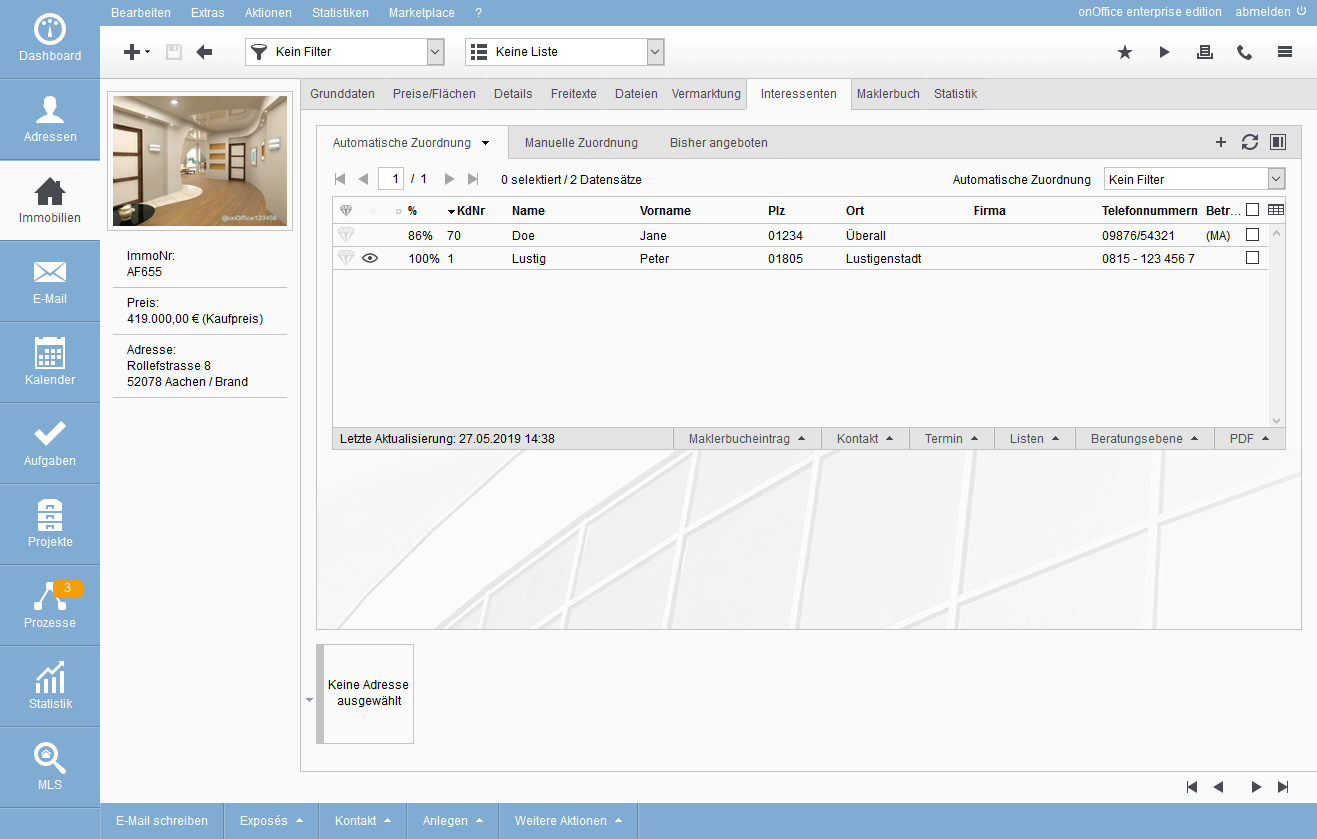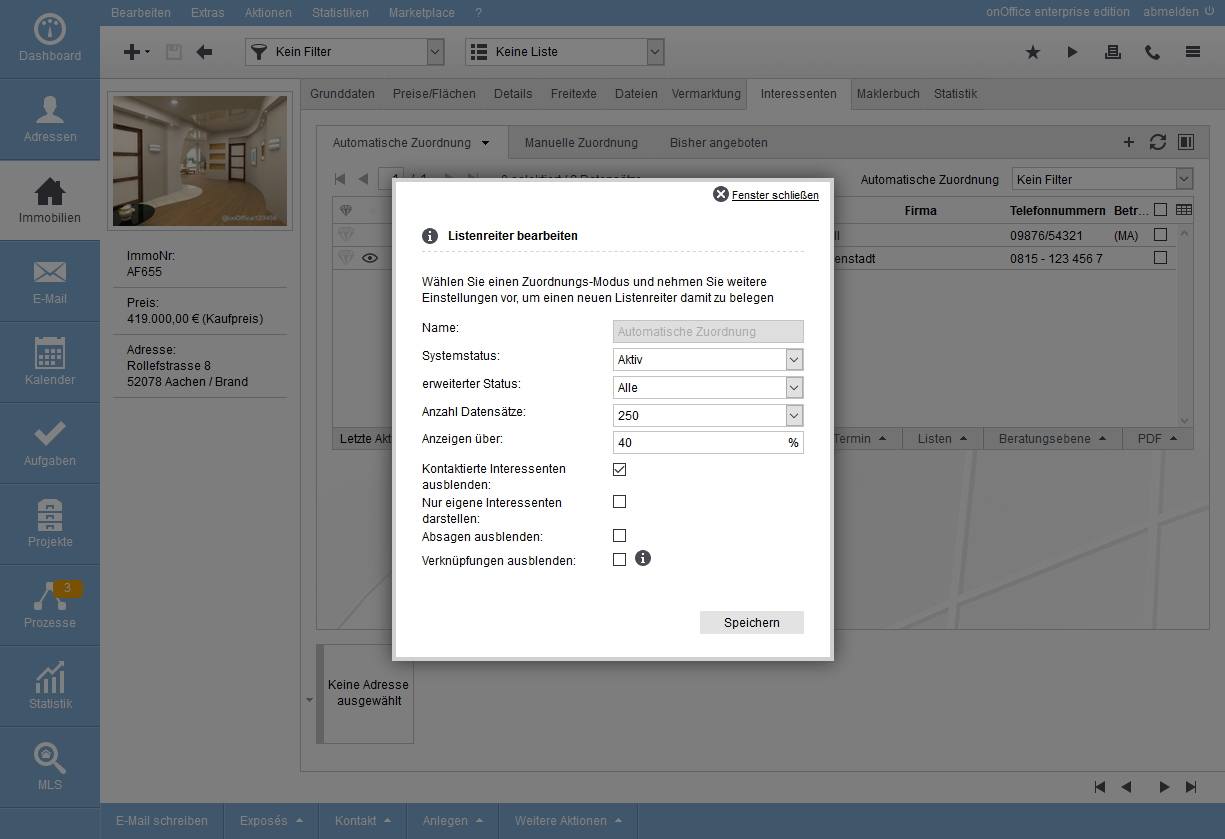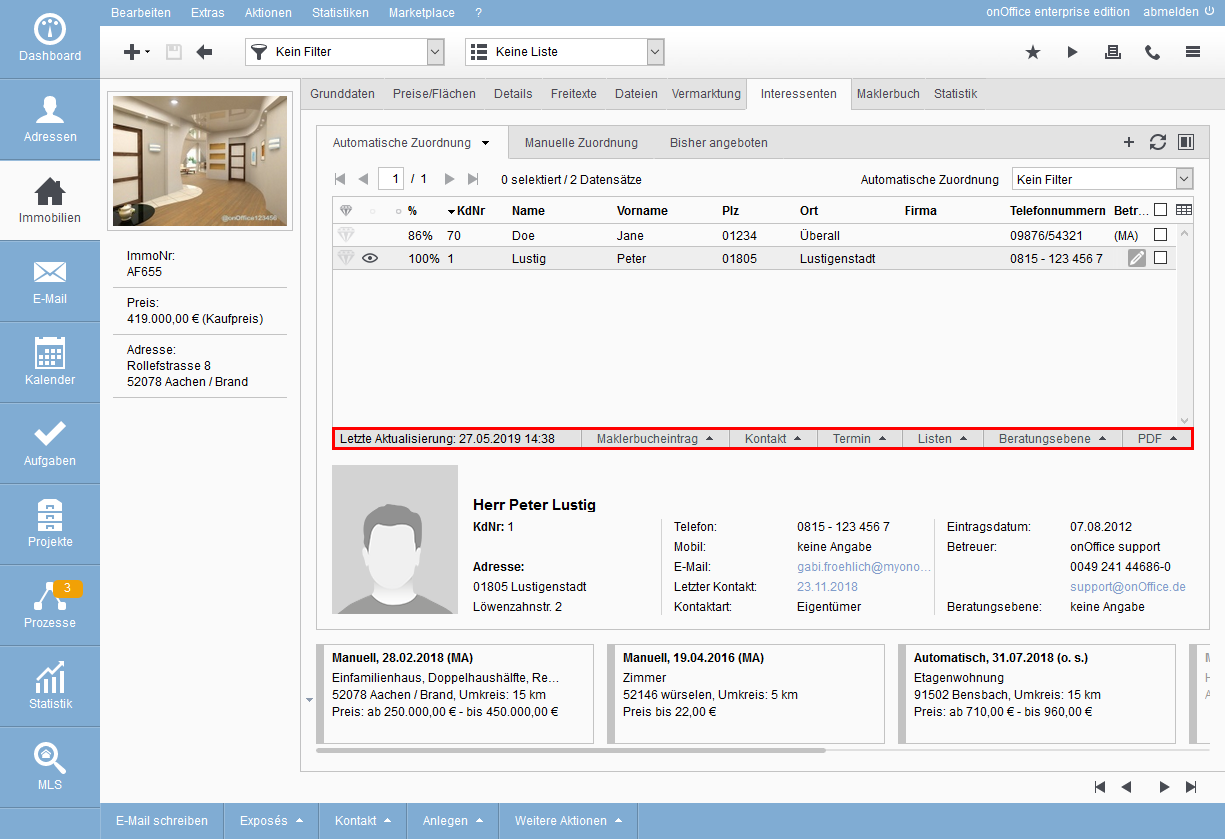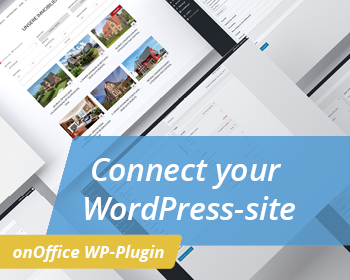You are here: Home / Modules / Properties / Detailed property view / Interested parties – overview / Property search - Details
Properties
Property search – Details
property search
In addition to the overview of the property search and the tutorial , the search profiles, the function of the property search, the presentation of the results and the further steps are dealt with in detail here. You can find more information about search profiles in the property search in Contact records.
With the “property search” you can examine properties and prospective customers in your database for “matching pairs”. The basis for the property search are the search profiles, which are managed in the tab “Property search” in the contact data records. However, for selected contacts in the result list, they can be changed directly here.
You can view the property details below or on the right. If you have a long list of suitable prospects, it is a good idea to display the details on the right-hand side, and you can also reduce the height of the search profile bar.
With the result of the property search, further actions are then possible, for example, you can directly send an offer to the interested party for a property.
Use property search
The property search with results list and detailed view takes up the central place of the tab. Based on the search profiles, the property search looks for properties matching the current contact data record . The result of the search is then displayed as a table list – by default in the “Automatic assignment” list tab. As usual, the list tabs and the table itself can be customized to your own preferences, just like in the contact module. The list rider configuration has been extended to include the settings for the property search. In addition to the settings in the list tab configuration, the result can be narrowed down using an contact filter at the top right of the navigation area. This filter applies to all list tabs.
A practical example for a property search and an offer mail can be found in the tutorials, here the configuration and the interrelationships are explained in more detail.
Search versus display
Although it sounds trivial, an important point is the difference between display and search. The result of the property search is stored in the background and the prospects to be displayed are listed according to the configuration of the list rider. If a match of at least 75% is set instead of a match of at least 90%, the list view of the prospects will be rebuilt, but NOT the search result will be redetermined. The date and time of the last update are displayed at the bottom left of the list action bar. To refresh the search results, there is a Refresh button ![]() at the top right of the list. However, there is one fundamental exception to this: When you open the Property search tab, the results list is updated once – i.e. also each time you switch tabs.
at the top right of the list. However, there is one fundamental exception to this: When you open the Property search tab, the results list is updated once – i.e. also each time you switch tabs.
This automatic update can be changed in the user settings via the option “Automatically update search results when entering the property search”. Without this option, the results list for this property will remain in the background even if you change tabs or switch to another module.
To be more precise, the update is not carried out when the property search tab is opened, but when a list tab with the “automatic assignment” mode is opened for the address status set there for the first time – and therefore for all list tabs that have the same combination of mode and status. If there are 2 list tabs for automatic assignment with different status specifications, the update for this status is only triggered when this list tab is opened.
How do you search?
The property search matches all active search profiles of contacts with the properties of the current property. For each pair of search profile and property, a match value is calculated and displayed as a percentage in the list. A match for all specified criteria then results in 100%, for each deviation the value is reduced. A conclusion from the percentage value to the deviating property is not possible, via the detailed view the search profiles of the interested party are listed and you can then check them.
Criteria that are setas KO criteria do not result in a deviation. On the other hand, the property must meet these requirements in full, otherwise it will not be considered suitable. Thus, if all criteria are KO criteria, only fully matching properties would be offered. Why isn’t that the default? Example: A prospective buyer is looking for a property with a purchase price of up to €350,000, an otherwise suitable property is on offer for €360,000. If the purchase price is a knockout criterion, this prospect will not be found as a match. However, it may well be that the difference of €10,000 is not an obstacle in the negotiation and the property can be brokered by you. Similarly for the type of property, etc.
Result list, what is output?
The result of the property search is displayed as a list of more or less suitable interested parties. This list can be further filtered and narrowed down to find the ideal prospects.
First, the view goes to the number of displayed prospects above the list of results, as well as in the list to the column with the match. In the case of very extensive lists, this can be narrowed down further, e.g. by displaying only your own prospects or by selecting an contact filter.
If the result does not contain any matching prospects, you can, for example, lower the minimum percentage value for the match or not only display your own prospects.
Besides the sorting and the contact filter , all other options are set via the list rider configuration. If you often use certain other filtering in addition to the standard criteria, you can create and configure corresponding list tabs for them.
For example, the list tab “Automatic assignment” could display only interested parties with a match above 80%. Another list rider could set the match to 60%.
Some list entries are highlighted in color and some activities are displayed as icons in the list. The following table provides an overview.
| Font color / symbol | Explanation |
|---|---|
| Green | Interested party already contacted |
| Red | Interested party has cancelled |
| = viewing appointment arranged | |
| = Visiting appointment canceled |
Results list, what next?
For hits with less than 100%, you can take a closer look at the prospect to verify the search profiles. Click on the entry in the list, then the most important details such as customer number, contact or contact details and supervisor etc. are displayed at the bottom / right.
The search profiles of the selected interested party are displayed below as a row. The match as a percentage of the profile with the property is displayed in each tile. You can view more information about the search profile via the magnifying glass preview ![]() . Criteria that the property does not meet are displayed in red.
. Criteria that the property does not meet are displayed in red.
You can create, edit or delete search profiles for the contact record. This works analogously to the search profiles in contacts and is explained there in detail. The search profile bar can also be collapsed.
Click on the hover icon “Enter purchase price offer” to open a lightbox in which you can manually enter a purchase price offer for this interested party. Older, possibly existing purchase price offers are overwritten. When a purchase price offer is changed, an activity is written to the address and property concerned.
The purchase price offers can be configured as a separate column “Purchase price offer (interested party)” for the list on the tabs Property search for addresses and Interested parties for properties. In the property feedback via the “Activate purchase price offer” option, you can also directly request purchase price offers from your customers, e.g. after you have carried out a viewing.
You can use the list actions below the results list to carry out further actions with the result or a selection from it. For example, you can send an email with brochures, create an appointment, create an activity (e.g. not reached on a call), create work lists or send an brochure directly via the “1-click brochure” entry.
Compared to the action bar in the property data record, the list actions have the advantage that the selected addresses are already transferred as a link / addressee, e.g. in the email composer.
The symbol in the Contact column (can be set via the “Preferred form of contact” field in the details of an address) indicates how the interested party would prefer to be contacted.
Use the list actions from “Contact” to define a relationship between a contact record and a property record. The status of this relationship is noted as “advisory level” and explained below.
With Activities / agent’s log Entry you can create activities for the selected records. This entry only appears if you have the user right“Activities mass update“.
Result list, other interested parties
As with all lists, only contacts for which you have read permission are displayed. With the corresponding user right (” showother interested parties”), other matching interested parties are also displayed in encrypted form. Click “Request Access” to send the property manager an email with your contact information.
Manual Assignments” and “Previously Offered” list tabs
You know someone interested in this property who was not shown in the automatic property search and would like to list them here as a potential buyer? You can use the “Manual assignment” list tab to keep a corresponding list of assignments and include additional prospects ![]() . Again, you can customize the view via contact filters and list rider configuration as well as use list actions.
. Again, you can customize the view via contact filters and list rider configuration as well as use list actions.
An offered property is of course noted in the property’s agent’s log and as a corresponding activity in the contact record. A quick clear list can be found here in the “Interested Parties” tab with the “Previously Offered” list tab. Here, all interested parties are listed for which a agent’s log entry exists that is linked to the respective property. In addition, you can display two columns on the “Previously offered” tab via the list configuration. These are “offered on”, which is based on the date of the last activity between the property and the prospective buyer, and “offered for”, which lists the purchase price at the time of the activity.
Advisory level
From the many matching pairs in the property search, some are highlighted by a link to each other. This relationship is defined as the level of consultation between a prospect and a property.
The consulting level describes in which stage of the sales process the prospect is. The consulting levels are defined from A (lease/purchase agreement signed) to G (cancellation).
You can set this consultation level manually, e.g. via the list actions in the Property search tab or in Activities.
However, it is also set automatically, e.g. in the following cases:
- Consultation Level E: When a letter/mail with contact or property reference is sent to the prospect or a file/brochure is sent from the property, if the consultation level was previously F or empty.
- Consultation Level C: If the prospective customer gives positive feedback during the property feedback.
- Consultation Level G: If the prospective customer gives negative feedback in the property feedback.
However, automatic actions can also depend on the consultation level: E.g. the automatic brochure dispatch for contact-property pairs checks whether an offer has already been created with one of the following consulting levels: A, B, C, D, E. If not, an offer will be sent automatically.
Below is a table showing the different levels of advice.
| Advisory level | Explanation | Font color |
|---|---|---|
| A | Rental/purchase agreement signed | Green |
| B | Written rental/purchase commitment | Green |
| C | in intensive conversation | Green |
| D | Interested, but still examining | Green |
| E | Receive documentation | Green |
| F | Documentation ordered | Green |
| G | Cancel | Red |
To be more precise, the update is not carried out when the property search tab is opened, but when a list tab with the “automatic assignment” mode is opened for the address status set there for the first time – and therefore for all list tabs that have the same combination of mode and status. If there are 2 list tabs for automatic assignment with different status specifications, the update for this status is only triggered when this list tab is opened.

 Introduction
Introduction Dashboard
Dashboard Addresses
Addresses Properties
Properties Email
Email Calender
Calender Tasks
Tasks Acquisition Cockpit
Acquisition Cockpit Audit-proof mail archiving
Audit-proof mail archiving Automatic brochure distribution
Automatic brochure distribution Billing
Billing Groups
Groups Intranet
Intranet Marketing box
Marketing box Multi Property module
Multi Property module Multilingual Module
Multilingual Module onOffice sync
onOffice sync Presentation PDFs
Presentation PDFs Process manager
Process manager Project management
Project management Property value analyses
Property value analyses Request manager
Request manager Showcase TV
Showcase TV Smart site 2.0
Smart site 2.0 Statistic Tab
Statistic Tab Statistics toolbox
Statistics toolbox Success cockpit
Success cockpit Time recording
Time recording Address from clipboard
Address from clipboard Boilerplates
Boilerplates Customer communication
Customer communication External Tools
External Tools Favorite links
Favorite links Formulas and calculating
Formulas and calculating Mass update
Mass update onOffice-MLS
onOffice-MLS Portals
Portals Property import
Property import Quick Access
Quick Access Settings
Settings Templates
Templates Step by step
Step by step